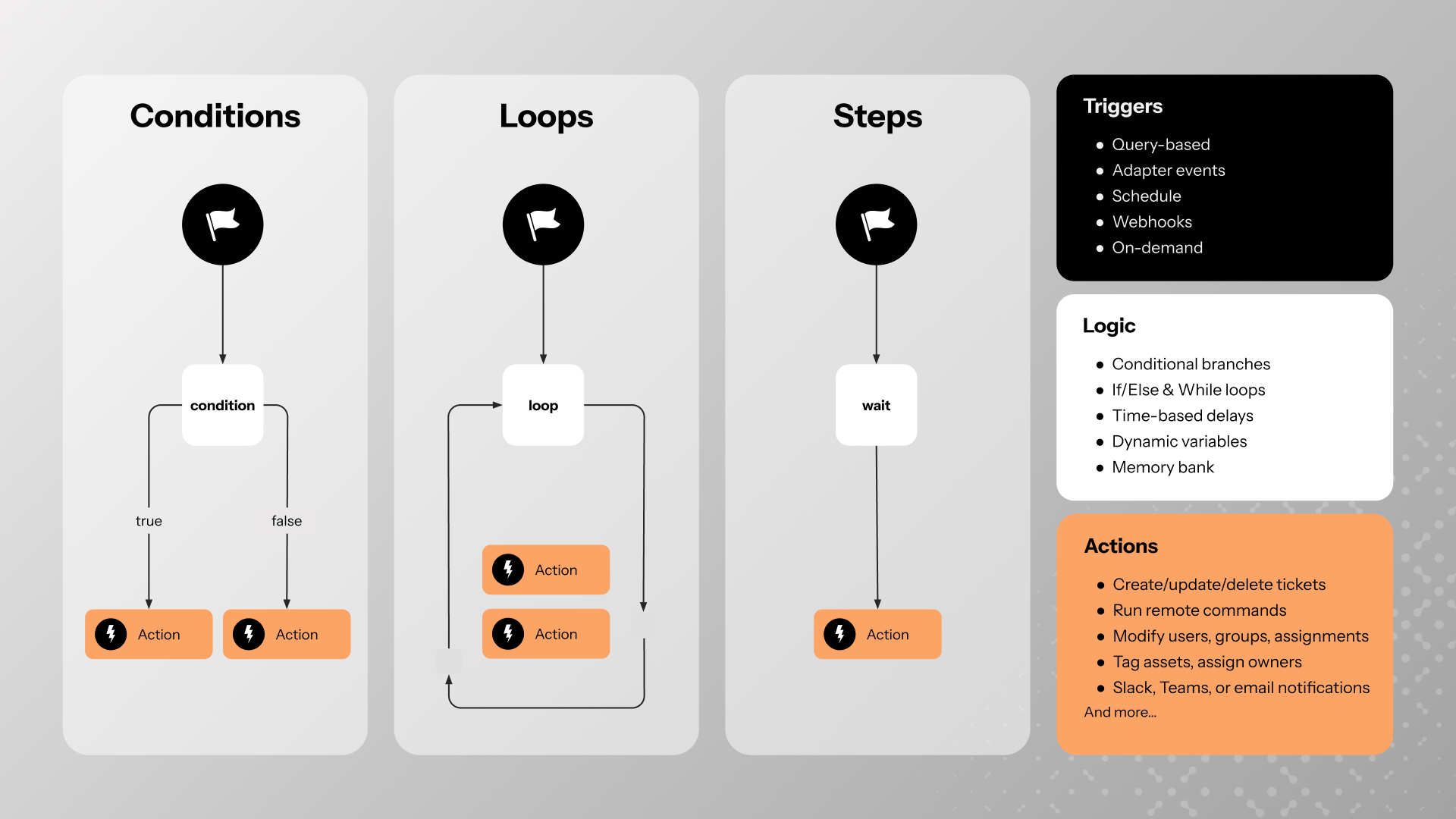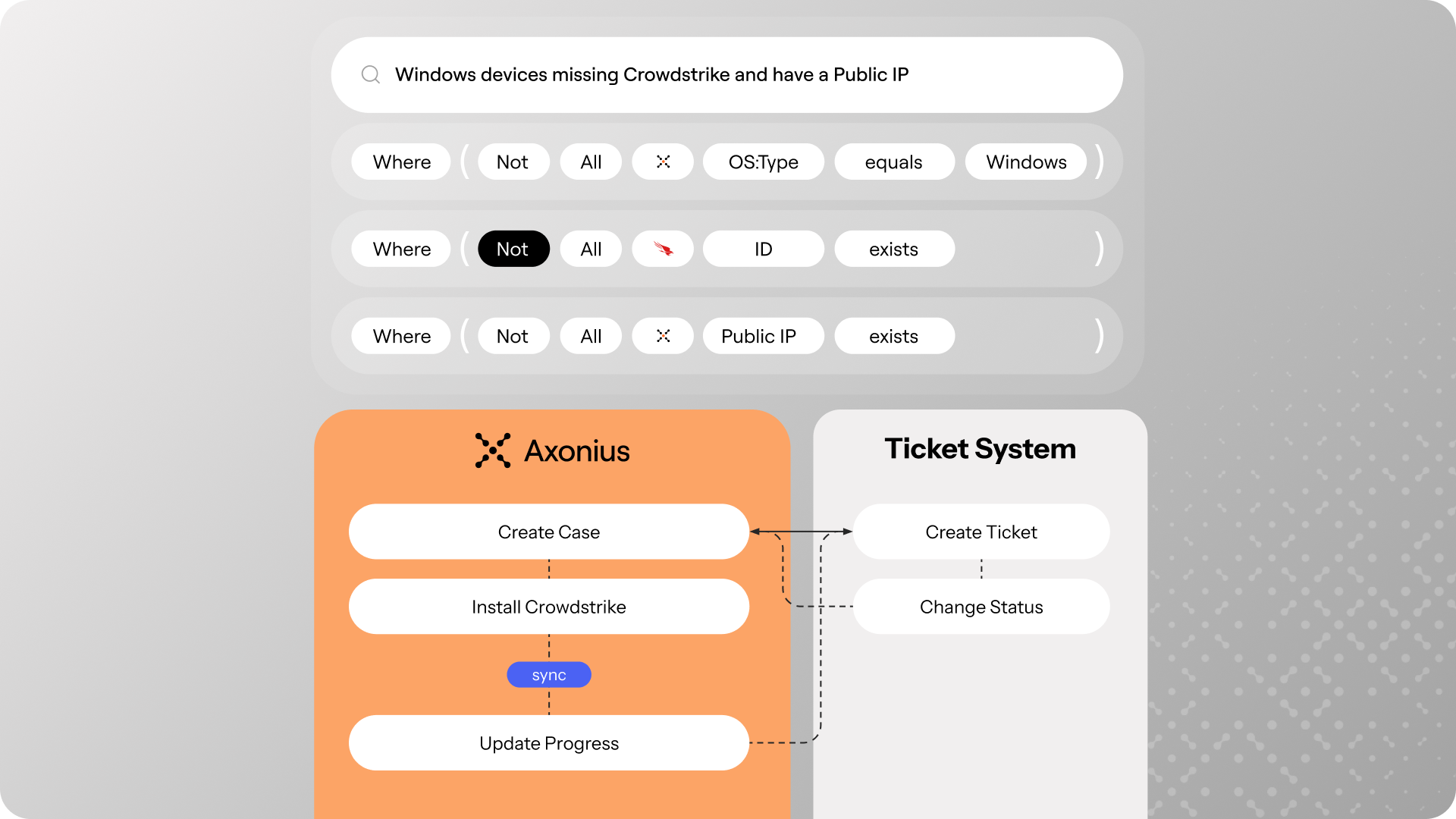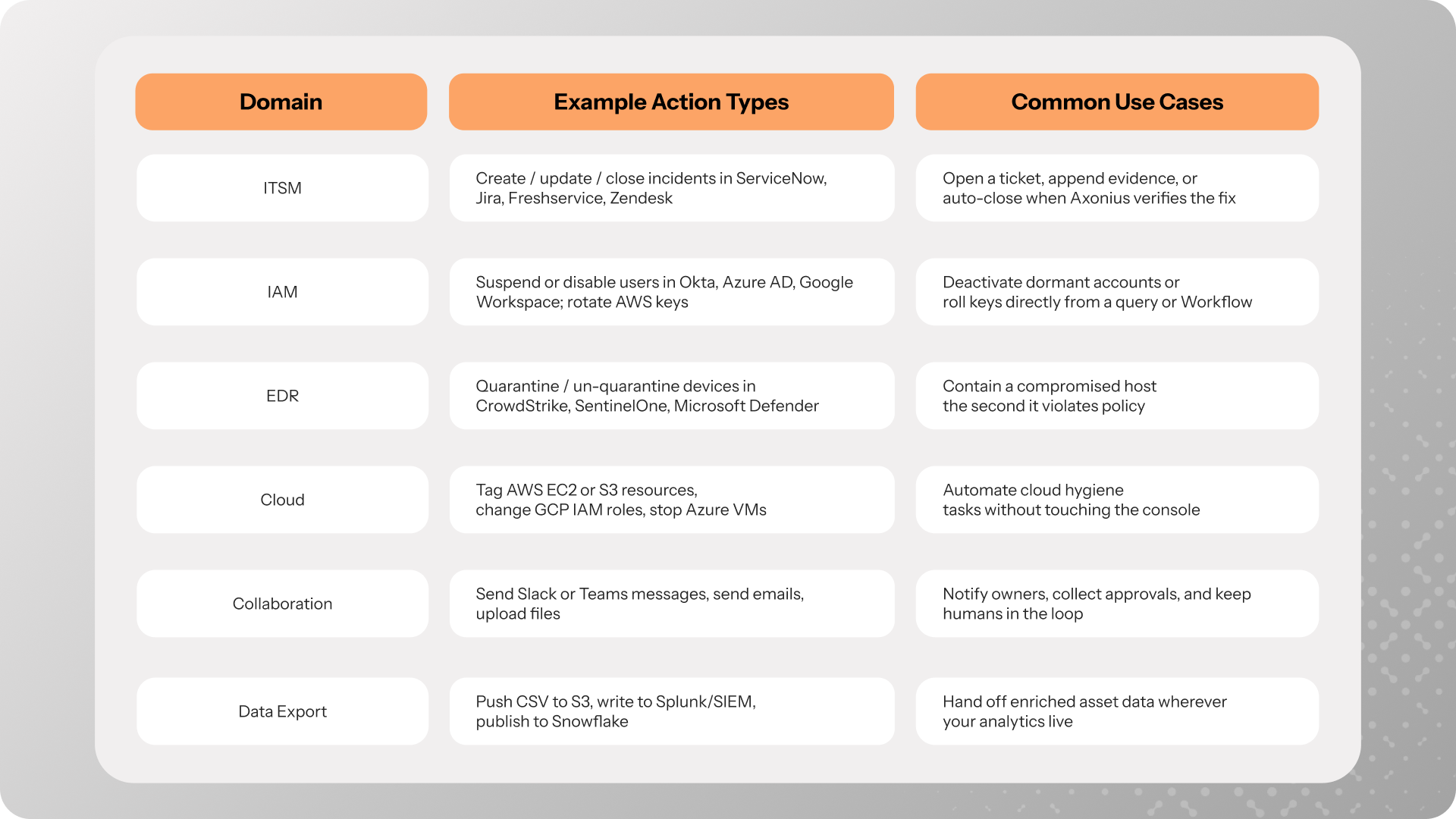Launch Week Day 1: Platform Actionability

Ivan Dwyer
Product Marketing, Axonius

Launch Week Day 1 – Welcome to the Actionability Era.
Why do we need to leap towards a more proactive mode of cybersecurity? Because visibility is table stakes and only gets you so far. There’s plenty of tools to help uncover risks across your attack surface, but ironically, the more you see, the harder it becomes to act – especially when context and control are spread across fragmented tools and teams.
We call this the Actionability Gap – the crucial space between detection and remediation within your team’s capacity. Axonius has laid the foundation to closing this gap with asset intelligence across the attack surface – devices, identities, applications, infrastructure, and more. Our customers of all kinds and sizes tap into the market-leading Adapter Network to turn insights into action across every cyber domain.
The same asset intelligence foundation that enables aggregate visibility now powers aggregate action. At the aggregate matters – fragmented insights show only part of the picture, and fragmented actions address only part of the attack surface, yet real-world exploits cut across multiple domains more often than not. True actionability means continuously orchestrating fixes across every domain, while keeping each team on the same context-rich data platform. The result? Self-healing environments proactively addressing exposures, misconfigurations, and inefficiencies before they become issues.
Today’s launch showcases three critical capabilities across the Axonius Asset Cloud that help make proactive actionability a reality: Workflows, Ticket Binding, and 500+ Actions.
Workflows: From One-Shots to Full Flows
Axonius has long let you fire off a single action directly from a saved query via Enforcement Sets – open a ticket, disable a user, quarantine a device, notify the team, and a whole lot more. For many tasks, that one-shot is perfect: fast, repeatable, automatic.
But many issues span multiple steps and cross multiple teams – think patch campaigns, leaver clean-ups, or alert triage. That’s where Workflows comes in. Workflows is a visual, no-code automation builder inside the Axonius Asset Cloud that lets you chain logical actions together from event-driven triggers, so you can orchestrate end-to-end processes across Security, IT, and Identity domains from one place.
How it Works

Set Trigger: Kick off a flow when a query changes, an adapter event fires, a webhook arrives, on a schedule, or manually.
Configure Logic: Arrange if/else branches, for-each loops, variables, and delays to map the exact steps you need.
Add Actions: Select from 500+ ready-made tasks: open or update tickets, disable users, push patches, send Slack, tag assets, and more.
Track Progress: Every run logs inputs, outputs, and pass/fail status so you can troubleshoot or iterate in seconds.
Workflows in Action
Use Case | Workflow |
Critical CVE Patch Loop | Trigger: Vulnerability scanner flags CVSS ≥ 8 on a crown-jewel asset Steps: Open Jira ticket → push patch through MDM → for-each loop rechecks device health → auto-close ticket when asset reports compliant. |
Leaver Lifecycle Automation | Trigger: HR termination webhook from Workday Steps: Disable user in Okta → revoke SaaS roles (Zoom, Salesforce, etc.) → wipe laptop via Intune → write audit evidence to ServiceNow. |
EDR Coverage Enforcement | Trigger: Saved query returns “device missing EDR agent” Steps: Slack asset owner → attempt auto-install agent → delay 24 h → if agent still absent, reopen ticket and escalate. |
Learn more about Workflows in the Docs
Case Sets: No More Swivel Chair Operations
When remediation work leaves the Axonius console into ServiceNow, Jira, or another system, teams are often left in the dark. Updates go missing, statuses drift, and analysts bounce between tabs trying to reconcile what’s fixed and what isn’t.
Case Sets ends the swivel-chair operations by linking Axonius Cases with external tickets in a truly bi-directional flow – not just syncing metadata, but tracking the actual state of affected assets to verify when the issue is resolved.
Because Cases are built directly from saved queries, Axonius is uniquely positioned to track the real-world state of assets as remediation progresses. You're not just assuming the ticket is closed, you're seeing the change happen.
How it Works

Create a Case: start from any saved query or Finding that defines the issue and the desired state. Cases can be one-time or recurring (e.g., a weekly patch validation).
Link Case: connect the Case to a new ticket in ServiceNow, Jira, or another supported system.
Track state: Axonius reruns the query on every discovery cycle, updating Case progress and syncing status, assignee, and resolution across both systems.
Take Action: you can trigger downstream workflows based on Case resolution, ticket updates, or changes in asset status.
Verify Closure: when the query returns zero results (as-in desired state reached), Axonius can automatically close the Case and the linked ticket.
Case Sets in Action
Desired State | Case Flow |
All devices have EDR installed | Linked to an “Install Agent” task in ServiceNow. Progress auto-updates as agents deploy; Case and ticket close together when no unmanaged devices remain. |
No dormant privileged accounts | Linked to an IAM cleanup issue in Jira. Each disabled or deleted account moves the progress bar; Case and ticket resolve once every dormant privilege is gone. |
Critical CVEs on crown jewel assets fully patched | Linked to a remediation ticket in ServiceNow. Patch team works from their queue while Axonius tracks remaining vulnerable assets; both records close on full patch coverage. |
Not just another ticket system
Plenty of platforms push tickets, but Axonius monitors the actual state of your environment. Using our asset intelligence pipeline, we continuously verify whether issues have truly been resolved – not just marked "done."
And because Cases are query-driven and checked on every discovery cycle, they’re perfect for operationalizing policy: from recurring patch campaigns to ongoing compliance checks. Axonius doesn’t just route the work – we define the baseline, track the fix, and confirm the resolution.
Learn more about Case Management in the Docs.
500+ Actions: Expanding Breadth and Depth

When we talk about actionability at the aggregate, the numbers matter. We’ve now crossed over 500 pre-built Enforcement Center actions, each one a ready-to-run task you can drop into a Workflow or fire off as an Enforcement Set.
Domain | Example Action Types | Common Use Cases |
ITSM | Create / update / close incidents in ServiceNow, Jira, Freshservice, Zendesk | Open a ticket, append evidence, or auto-close when Axonius verifies the fix |
IAM | Suspend or disable users in Okta, Azure AD, Google Workspace; rotate AWS keys | Deactivate dormant accounts or roll keys directly from a query or Workflow |
EDR | Quarantine / un-quarantine devices in CrowdStrike, SentinelOne, Microsoft Defender | Contain a compromised host the second it violates policy |
Cloud | Tag AWS EC2 or S3 resources, change GCP IAM roles, stop Azure VMs | Automate cloud hygiene tasks without touching the console |
Collaboration | Send Slack or Teams messages, send emails, upload files | Notify owners, collect approvals, and keep humans in the loop |
Data Export | Push CSV to S3, write to Splunk/SIEM, publish to Snowflake | Hand off enriched asset data wherever your analytics live |
New and Noteworthy Actions
Adapter | Action(s) | Example Use Case |
Crowdstrike Falcon | Quarantine / Release Device | Isolate infected endpoints directly from a high-sev SIEM alert |
Okta | Reset Factor | Force step-up auth after a risky login |
Jira | Add Comment | Update an existing ticket with Axonius evidence instead of creating a new issue |
AWS | Upload File to S3 | Drop continuous asset exports into an S3 bucket for long-term analytics |
Slack | Upload File & Message | Ship a CSV of non-compliant devices straight to the #it-ops channel |
Azure AD | Revoke User Session | Kick users out immediately after a credential rotation or termination event |
Learn more about the Enforcement Actions Library in the Docs
Wrap Up: Take Action Towards Actionability
Day 1 of Launch Week stresses the fact that Axonius is no longer just the place you see your environment – it’s also the place you fix it. With Workflows, Ticket Binding, and 500+ Actions, you can now:
- Orchestrate multi-step remediations across domains without a single line of code
- Tie every Axonius Case to the ticket systems your teammates already live in
- Leverage the industry’s broadest action library to close the loop automatically
Put together, these core asset intelligence capabilities enable a self-healing environment where risk is discovered, prioritized, and remediated in one continuous motion.
More from Launch Week
See all the action for Launch Week here.
Exposures in Action: turn findings into automatic fixes at scale.
Identities in Action: lifecycle and governance flows that keep access in line with policy.
Actionable UX Enhancements: a fresh look and feel for the Axonius console and API.
If you’re new to Axonius, book a demo to see Actionability in action for yourself

Get Started
Discover what’s achievable with a product demo, or talk to an Axonius representative.
